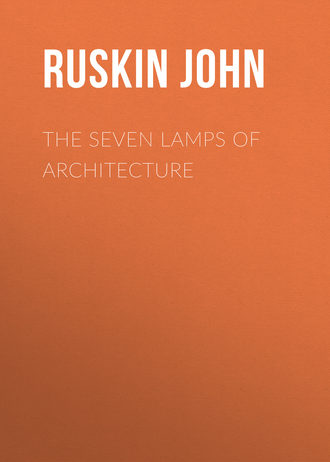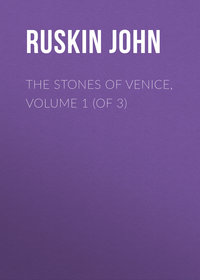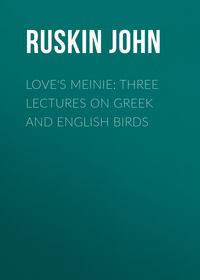 полная версия
полная версияThe Seven Lamps of Architecture
X. Nor is there, indeed, any present loss, in such respect, for futurity. Every human action gains in honor, in grace, in all true magnificence, by its regard to things that are to come. It is the far sight, the quiet and confident patience, that, above all other attributes, separate man from man, and near him to his Maker; and there is no action nor art, whose majesty we may not measure by this test. Therefore, when we build, let us think that we build for ever. Let it not be for present delight, nor for present use alone; let it be such work as our descendants will thank us for, and let us think, as we lay stone on stone, that a time is to come when those stones will be held sacred because our hands have touched them, and that men will say as they look upon the labor and wrought substance of them, "See! this our fathers did for us." For, indeed, the greatest glory of a building is not in its stones, or in its gold. Its glory is in its Age, and in that deep sense of voicefulness, of stern watching, of mysterious sympathy, nay, even of approval or condemnation, which we feel in walls that have long been washed by the passing waves of humanity. It is in their lasting witness against men, in their quiet contrast with the transitional character of all things, in the strength which, through the lapse of seasons and times, and the decline and birth of dynasties, and the changing of the face of the earth, and of the limits of the sea, maintains its sculptured shapeliness for a time insuperable, connects forgotten and following ages with each other, and half constitutes the identity, as it concentrates the sympathy, of nations; it is in that golden stain of time, that we are to look for the real light, and color, and preciousness of architecture; and it is not until a building has assumed this character, till it has been entrusted with the fame, and hallowed by the deeds of men, till its walls have been witnesses of suffering, and its pillars rise out of the shadows of death, that its existence, more lasting as it is than that of the natural objects of the world around it, can be gifted with even so much as these possess of language and of life.
XI. For that period, then, we must build; not, indeed, refusing to ourselves the delight of present completion, nor hesitating to follow such portions of character as may depend upon delicacy of execution to the highest perfection of which they are capable, even although we may know that in the course of years such details must perish; but taking care that for work of this kind we sacrifice no enduring quality, and that the building shall not depend for its impressiveness upon anything that is perishable. This would, indeed, be the law of good composition under any circumstances, the arrangement of the larger masses being always a matter of greater importance than the treatment of the smaller; but in architecture there is much in that very treatment which is skilful or otherwise in proportion to its just regard to the probable effects of time: and (which is still more to be considered) there is a beauty in those effects themselves, which nothing else can replace, and which it is our wisdom to consult and to desire. For though, hitherto, we have been speaking of the sentiment of age only, there is an actual beauty in the marks of it, such and so great as to have become not unfrequently the subject of especial choice among certain schools of art, and to have impressed upon those schools the character usually and loosely expressed by the term "picturesque." It is of some importance to our present purpose to determine the true meaning of this expression, as it is now generally used; for there is a principle to be developed from that use which, while it has occultly been the ground of much that is true and just in our judgment of art, has never been so far understood as to become definitely serviceable. Probably no word in the language (exclusive of theological expressions), has been the subject of so frequent or so prolonged dispute; yet none remained more vague in their acceptance, and it seems to me to be a matter of no small interest to investigate the essence of that idea which all feel, and (to appearance) with respect to similar things, and yet which every attempt to define has, as I believe, ended either in mere enumeration of the effects and objects to which the term has been attached, or else in attempts at abstraction more palpably nugatory than any which have disgraced metaphysical investigation on other subjects. A recent critic on Art, for instance, has gravely advanced the theory that the essence of the picturesque consists in the expression of "universal decay." It would be curious to see the result of an attempt to illustrate this idea of the picturesque, in a painting of dead flowers and decayed fruit, and equally curious to trace the steps of any reasoning which, on such a theory, should account for the picturesqueness of an ass colt as opposed to a horse foal. But there is much excuse for even the most utter failure in reasonings of this kind, since the subject is, indeed, one of the most obscure of all that may legitimately be submitted to human reason; and the idea is itself so varied in the minds of different men, according to their subjects of study, that no definition can be expected to embrace more than a certain number of its infinitely multiplied forms.
XII. That peculiar character, however, which separates the picturesque from the characters of subject belonging to the higher walks of art (and this is all that is necessary for our present purpose to define), may be shortly and decisively expressed. Picturesqueness, in this sense, is Parasitical Sublimity. Of course all sublimity, as well as all beauty, is, in the simple etymological sense, picturesque, that is to say, fit to become the subject of a picture; and all sublimity is, even in the peculiar sense which I am endeavoring to develope, picturesque, as opposed to beauty; that is to say, there is more picturesqueness in the subject of Michael Angelo than of Perugino, in proportion to the prevalence of the sublime element over the beautiful. But that character, of which the extreme pursuit is generally admitted to be degrading to art, is parasitical sublimity; i.e., a sublimity dependent on the accidents, or on the least essential characters, of the objects to which it belongs; and the picturesque is developed distinctively exactly in proportion to the distance from the centre of thought of those points of character in which the sublimity is found. Two ideas, therefore, are essential to picturesqueness,—the first, that of sublimity (for pure beauty is not picturesque at all, and becomes so only as the sublime element mixes with it), and the second, the subordinate or parasitical position of that sublimity. Of course, therefore, whatever characters of line or shade or expression are productive of sublimity, will become productive of picturesqueness; what these characters are I shall endeavor hereafter to show at length; but, among those which are generally acknowledged, I may name angular and broken lines, vigorous oppositions of light and shadow, and grave, deep, or boldly contrasted color; and all these are in a still higher degree effective, when, by resemblance or association, they remind us of objects on which a true and essential sublimity exists, as of rocks or mountains, or stormy clouds or waves. Now if these characters, or any others of a higher and more abstract sublimity, be found in the very heart and substance of what we contemplate, as the sublimity of Michael Angelo depends on the expression of mental character in his figures far more than even on the noble lines of their arrangement, the art which represents such characters cannot be properly called picturesque: but, if they be found in the accidental or external qualities, the distinctive picturesque will be the result.
XIII. Thus, in the treatment of the features of the human face by Francia or Angelico, the shadows are employed only to make the contours of the features thoroughly felt; and to those features themselves the mind of the observer is exclusively directed (that is to say, to the essential characters of the thing represented). All power and all sublimity rest on these; the shadows are used only for the sake of the features. On the contrary, by Rembrandt, Salvator, or Caravaggio, the features are used for the sake of the shadows; and the attention is directed, and the power of the painter addressed to characters of accidental light and shade cast across or around those features. In the case of Rembrandt there is often an essential sublimity in invention and expression besides, and always a high degree of it in the light and shade itself; but it is for the most part parasitical or engrafted sublimity as regards the subject of the painting, and, just so far, picturesque.
XIV. Again, in the management of the sculptures of the Parthenon, shadow is frequently employed as a dark field on which the forms are drawn. This is visibly the case in the metopes, and must have been nearly as much so in the pediment. But the use of that shadow is entirely to show the confines of the figures; and it is to their lines, and not to the shapes of the shadows behind them, that the art and the eye are addressed. The figures themselves are conceived as much as possible in full light, aided by bright reflections; they are drawn exactly as, on vases, white figures on a dark ground: and the sculptors have dispensed with, or even struggled to avoid, all shadows which were not absolutely necessary to the explaining of the form. On the contrary, in Gothic sculpture, the shadow becomes itself a subject of thought. It is considered as a dark color, to be arranged in certain agreeable masses; the figures are very frequently made even subordinate to the placing of its divisions: and their costume is enriched at the expense of the forms underneath, in order to increase the complexity and variety of the points of shade. There are thus, both in sculpture and painting, two, in some sort, opposite schools, of which the one follows for its subject the essential forms of things, and the other the accidental lights and shades upon them. There are various degrees of their contrariety: middle steps, as in the works of Correggio, and all degrees of nobility and of degradation in the several manners: but the one is always recognised as the pure, and the other as the picturesque school. Portions of picturesque treatment will be found in Greek work, and of pure and unpicturesque in Gothic; and in both there are countless instances, as pre-eminently in the works of Michael Angelo, in which shadows become valuable as media of expression, and therefore take rank among essential characteristics. Into these multitudinous distinctions and exceptions I cannot now enter, desiring only to prove the broad applicability of the general definition.
XV. Again, the distinction will be found to exist, not only between forms and shades as subjects of choice, but between essential and inessential forms. One of the chief distinctions between the dramatic and picturesque schools of sculpture is found in the treatment of the hair. By the artists of the time of Pericles it was considered as an excrescence,16 indicated by few and rude lines, and subordinated in every particular to the principality of the features and person. How completely this was an artistical, not a national idea, it is unnecessary to prove. We need but remember the employment of the Lacedæmonians, reported by the Persian spy on the evening before the battle of Thermopylæ, or glance at any Homeric description of ideal form, to see how purely sculpturesque was the law which reduced the markings of the hair, lest, under the necessary disadvantages of material, they should interfere with the distinctness of the personal forms. On the contrary, in later sculpture, the hair receives almost the principal care of the workman; and while the features and limbs are clumsily and bluntly executed, the hair is curled and twisted, cut into bold and shadowy projections, and arranged in masses elaborately ornamental: there is true sublimity in the lines and the chiaroscuro of these masses, but it is, as regards the creature represented, parasitical, and therefore picturesque. In the same sense we may understand the application of the term to modern animal painting, distinguished as it has been by peculiar attention to the colors, lustre, and texture of skin; nor is it in art alone that the definition will hold. In animals themselves, when their sublimity depends upon their muscular forms or motions, or necessary and principal attributes, as perhaps more than all others in the horse, we do not call them picturesque, but consider them as peculiarly fit to be associated with pure historical subject. Exactly in proportion as their character of sublimity passes into excrescences;—into mane and beard as in the lion, into horns as in the stag, into shaggy hide as in the instance above given of the ass colt, into variegation as in the zebra, or into plumage,—they become picturesque, and are so in art exactly in proportion to the prominence of these excrescential characters. It may often be most expedient that they should be prominent; often there is in them the highest degree of majesty, as in those of the leopard and boar; and in the hands of men like Tintoret and Rubens, such attributes become means of deepening the very highest and most ideal impressions. But the picturesque direction of their thoughts is always distinctly recognizable, as clinging to the surface, to the less essential character, and as developing out of this a sublimity different from that of the creature itself; a sublimity which is, in a sort, common to all the objects of creation, and the same in its constituent elements, whether it be sought in the clefts and folds of shaggy hair, or in the chasms and rents of rocks, or in the hanging of thickets or hill sides, or in the alternations of gaiety and gloom in the variegation of the shell, the plume, or the cloud.
XVI. Now, to return to our immediate subject, it so happens that, in architecture, the superinduced and accidental beauty is most commonly inconsistent with the preservation of original character, and the picturesque is therefore sought in ruin, and supposed to consist in decay. Whereas, even when so sought, it consists in the mere sublimity of the rents, or fractures, or stains, or vegetation, which assimilate the architecture with the work of Nature, and bestow upon it those circumstances of color and form which are universally beloved by the eye of man. So far as this is done, to the extinction of the true characters of the architecture, it is picturesque, and the artist who looks to the stem of the ivy instead of the shaft of the pillar, is carrying out in more daring freedom the debased sculptor's choice of the hair instead of the countenance. But so far as it can be rendered consistent with the inherent character, the picturesque or extraneous sublimity of architecture has just this of nobler function in it than that of any other object whatsoever, that it is an exponent of age, of that in which, as has been said, the greatest glory of a building consists; and, therefore, the external signs of this glory, having power and purpose greater than any belonging to their mere sensible beauty, may be considered as taking rank among pure and essential character; so essential to my mind, that I think a building cannot be considered as in its prime until four or five centuries have passed over it; and that the entire choice and arrangement of its details should have reference to their appearance after that period, so that none should be admitted which would suffer material injury either by the weather-staining, or the mechanical degradation which the lapse of such a period would necessitate.
XVII. It is not my purpose to enter into any of the questions which the application of this principle involves. They are of too great interest and complexity to be even touched upon within my present limits, but this is broadly to be noticed, that those styles of architecture which are picturesque in the sense above explained with respect to sculpture, that is to say, whose decoration depends on the arrangement of points of shade rather than on purity of outline, do not suffer, but commonly gain in richness of effect when their details are partly worn away; hence such styles, pre-eminently that of French Gothic, should always be adopted when the materials to be employed are liable to degradation, as brick, sandstone, or soft limestone; and styles in any degree dependent on purity of line, as the Italian Gothic, must be practised altogether in hard and undecomposing materials, granite serpentine, or crystalline marbles. There can be no doubt that the nature of the accessible materials influenced the formation of both styles; and it should still more authoritatively determine our choice of either.
XVIII. It does not belong to my present plan to consider at length the second head of duty of which I have above spoken; the preservation of the architecture we possess: but a few words may be forgiven, as especially necessary in modern times. Neither by the public, nor by those who have the care of public monuments, is the true meaning of the word restoration understood. It means the most total destruction which a building can suffer: a destruction out of which no remnants can be gathered; a destruction accompanied with false description of the thing destroyed. Do not let us deceive ourselves in this important matter; it is impossible, as impossible as to raise the dead, to restore anything that has ever been great or beautiful in architecture. That which I have above insisted upon as the life of the whole, that spirit which is given only by the hand and eye of the workman, never can be recalled. Another spirit may be given by another time, and it is then a new building; but the spirit of the dead workman cannot be summoned up, and commanded to direct other hands, and other thoughts. And as for direct and simple copying, it is palpably impossible. What copying can there be of surfaces that have been worn half an inch down? The whole finish of the work was in the half inch that is gone; if you attempt to restore that finish, you do it conjecturally; if you copy what is left, granting fidelity to be possible (and what care, or watchfulness, or cost can secure it?), how is the new work better than the old? There was yet in the old some life, some mysterious suggestion of what it had been, and of what it had lost; some sweetness in the gentle lines which rain and sun had wrought. There can be none in the brute hardness of the new carving. Look at the animals which I have given in Plate 14, as an instance of living work, and suppose the markings of the scales and hair once worn away, or the wrinkles of the brows, and who shall ever restore them? The first step to restoration (I have seen it, and that again and again, seen it on the Baptistery of Pisa, seen it on the Casa d' Oro at Venice, seen it on the Cathedral of Lisieux), is to dash the old work to pieces; the second is usually to put up the cheapest and basest imitation which can escape detection, but in all cases, however careful, and however labored, an imitation still, a cold model of such parts as can be modelled, with conjectural supplements; and my experience has as yet furnished me with only one instance, that of the Palais de Justice at Rouen, in which even this, the utmost degree of fidelity which is possible, has been attained or even attempted.
XIX. Do not let us talk then of restoration. The thing is a Lie from beginning to end. You may make a model of a building as you may of a corpse, and your model may have the shell of the old walls within it as your cast might have the skeleton, with what advantage I neither see nor care; but the old building is destroyed, and that more totally and mercilessly than if it had sunk into a heap of dust, or melted into a mass of clay: more has been gleaned out of desolated Nineveh than ever will be out of re-built Milan. But, it is said, there may come a necessity for restoration! Granted. Look the necessity full in the face, and understand it on its own terms. It is a necessity for destruction. Accept it as such, pull the building down, throw its stones into neglected corners, make ballast of them, or mortar, if you will; but do it honestly, and do not set up a Lie in their place. And look that necessity in the face before it comes, and you may prevent it. The principle of modern times (a principle which I believe, at least in France, to be systematically acted on by the masons, in order to find themselves work, as the abbey of St. Ouen was pulled down by the magistrates of the town by way of giving work to some vagrants,) is to neglect buildings first, and restore them afterwards. Take proper care of your monuments, and you will not need to restore them. A few sheets of lead put in time upon the roof, a few dead leaves and sticks swept in time out of a water-course, will save both roof and walls from ruin. Watch an old building with an anxious care; guard it as best you may, and at any cost from every influence of dilapidation. Count its stones as you would jewels of a crown; set watches about it as if at the gates of a besieged city; bind it together with iron where it loosens; stay it with timber where it declines; do not care about the unsightliness of the aid; better a crutch than a lost limb; and do this tenderly, and reverently, and continually, and many a generation will still be born and pass away beneath its shadow. Its evil day must come at last; but let it come declaredly and openly, and let no dishonoring and false substitute deprive it of the funeral offices of memory.
XX. Of more wanton or ignorant ravage it is vain to speak; my words will not reach those who commit them, and yet, be it heard or not, I must not leave the truth unstated, that it is again no question of expediency or feeling whether we shall preserve the buildings of past times or not. We have no right whatever to touch them. They are not ours. They belong partly to those who built them, and partly to all the generations of mankind who are to follow us. The dead have still their right in them: that which they labored for, the praise of achievement or the expression of religious feeling, or whatsoever else it might be which in those buildings they intended to be permanent, we have no right to obliterate. What we have ourselves built, we are at liberty to throw down; but what other men gave their strength, and wealth, and life to accomplish, their right over does not pass away with their death; still less is the right to the use of what they have left vested in us only. It belongs to all their successors. It may hereafter be a subject of sorrow, or a cause of injury, to millions, that we have consulted our present convenience by casting down such buildings as we choose to dispense with. That sorrow, that loss we have no right to inflict. Did the cathedral of Avranches belong to the mob who destroyed it, any more than it did to us, who walk in sorrow to and fro over its foundation? Neither does any building whatever belong to those mobs who do violence to it. For a mob it is, and must be always; it matters not whether enraged, or in deliberate folly; whether countless, or sitting in committees; the people who destroy anything causelessly are a mob, and Architecture is always destroyed causelessly. A fair building is necessarily worth the ground it stands upon, and will be so until central Africa and America shall have become as populous as Middlesex; nor is any cause whatever valid as a ground for its destruction. If ever valid, certainly not now when the place both of the past and future is too much usurped in our minds by the restless and discontented present. The very quietness of nature is gradually withdrawn from us; thousands who once in their necessarily prolonged travel were subjected to an influence, from the silent sky and slumbering fields, more effectual than known or confessed, now bear with them even there the ceaseless fever of their life; and along the iron veins that traverse the frame of our country, beat and flow the fiery pulses of its exertions, hotter and faster every hour. All vitality is concentrated through those throbbing arteries into the central cities; the country is passed over like a green sea by narrow bridges, and we are thrown back in continually closer crowds upon the city gates. The only influence which can in any wise there take the place of that of the woods and fields, is the power of ancient Architecture. Do not part with it for the sake of the formal square, or of the fenced and planted walk, nor of the goodly street nor opened quay. The pride of a city is not in these. Leave them to the crowd; but remember that there will surely be some within the circuit of the disquieted walls who would ask for some other spots than these wherein to walk; for some other forms to meet their sight familiarly: like him who sat so often where the sun struck from the west, to watch the lines of the dome of Florence drawn on the deep sky, or like those, his Hosts, who could bear daily to behold, from their palace chambers, the places where their fathers lay at rest, at the meeting of the dark streets of Verona.











